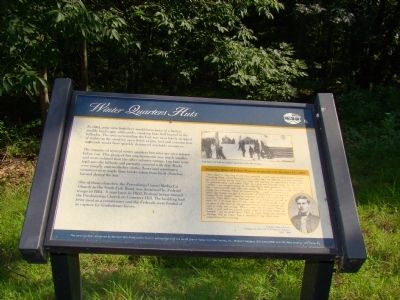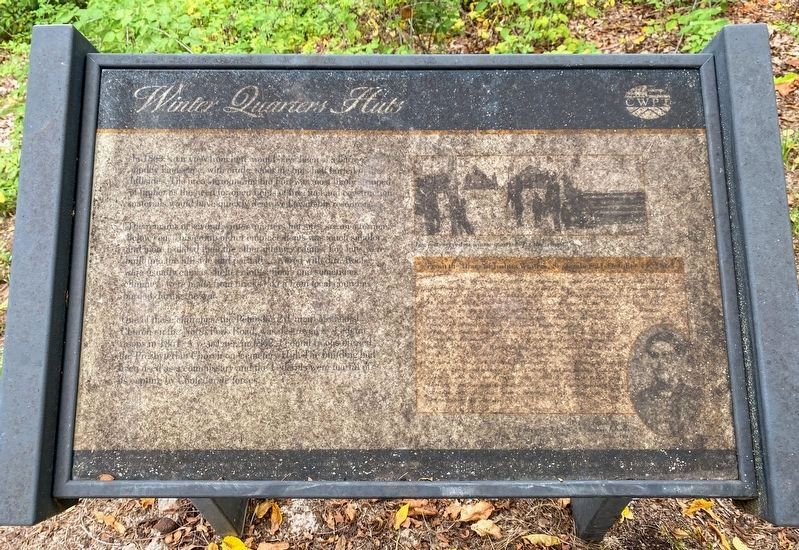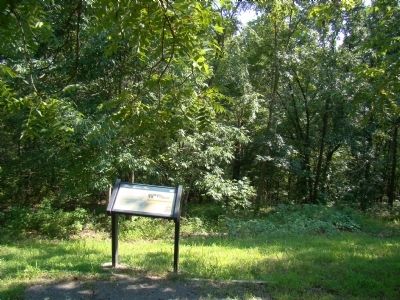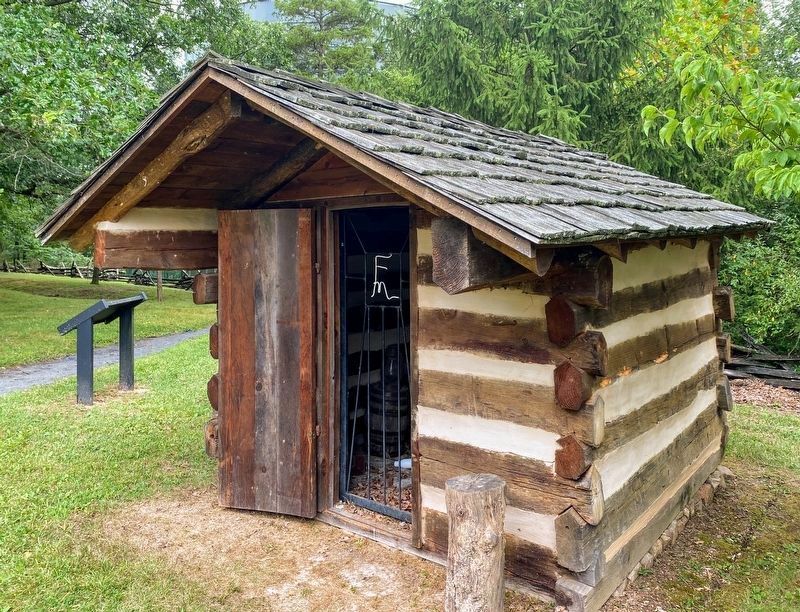Petersburg in Grant County, West Virginia — The American South (Appalachia)
Winter Quarters Huts
In 1863, your view from here would have been of a barren, muddy landscape, with crude, smoking huts half buried in the hillsides. The area surrounding the Fort was most likely stripped of timber as the need for open fields of fire, fuel and construction materials would have quickly destroyed available resources.
The remains of several winter quarters hut sites are on a terrace below you. This group of hut emplacements was much smaller and more isolated than the other infantry camps. Log huts were built into the hillside and partially covered with dirt. Roofs were usually canvas shelter cloths; floors and sometimes chimneys were made from bricks taken from local churches burned during the war.
One of these churches, the Petersburg (Union) Methodist Church on the North Fork Road, was destroyed by Federal troops in 1861. A year later, in 1862, Federal troops burned the Presbyterian Church on Cemetery Hill. The building had been used as a commissary and the Federals were fearful of its capture by Confederate forces.
From the Diary of Joshua Winters, September 21–October 11, 1863.
“Mon Sept 21. Vary larg frost this morning. i wet out 17 miles today on the Frankling Rode with the wagon train after hay. we started 6 in the morning, got back in the eaving. Tues 22. clear and nuthing of importence today. Wed 23. plesant days, cold nites. Thur 24. warm and plesant today. Fri 25. fair wethr. i am on gard today at Col Mulligans headqurters. Sat 26. plesant day. i am on pickit over the river today. Mon 28. fair wether. cut sum logs today for a house. Tues 29. warm today. i went with the train after hay today. we got it in 9 miles of Moorefield We go tpaid today for to munts. Wed 30. plesant wether. we raised our house. Thur Oct 1 1863. Plesant day. it commenced to rain at dark. Fri 2. it raind hard all day. clear and cold tonight. i am on gard in the fort at the qurtermaster. Sat 3. plesant day. Sun 4. clear and winday. Mon 5. clear and no noos. Tues 6 clear. i was out on a ass today. Wed 7. it raind today and tonight i am on pickit gard. Thur 8. clear today and nuthing strange. Sat 10. clear. Sun 11. beautiful day. thair was inspection this morning.”
Erected by Civil War Preservation Trust.
Topics. This historical marker is listed in this topic list: War, US Civil. A significant historical date for this entry is September 21, 1777.
Location. 39° 0.017′ N, 79° 8.45′ W. Marker is in Petersburg, West Virginia, in Grant County. Marker can be reached from Grant Memorial Hospital Parking south of West Virginia Route 55. Touch for map. Marker is in this post office area: Petersburg WV 26847, United States of America. Touch for directions.
Other nearby markers. At least 8 other
markers are within walking distance of this marker. The Impregnable Fortress (within shouting distance of this marker); Defending the Fort (within shouting distance of this marker); Protecting Supplies (about 400 feet away, measured in a direct line); The Last Days of Fort Mulligan (about 500 feet away); Civil War Cannons (about 500 feet away); A Strategic Location (about 600 feet away); Parrott Rifle (about 600 feet away); The Irish Brigade & the McNeill Rangers / The Civil War Comes to Hardy County (about 600 feet away). Touch for a list and map of all markers in Petersburg.
More about this marker. On the lower right is a portrait of “Private Joshua Winters, First (W) VA Volunteer Infantry (1843–1900).”
Credits. This page was last revised on December 17, 2020. It was originally submitted on December 20, 2008, by J. J. Prats of Powell, Ohio. This page has been viewed 1,632 times since then and 17 times this year. Last updated on August 30, 2020, by Bradley Owen of Morgantown, West Virginia. Photos: 1. submitted on December 20, 2008, by J. J. Prats of Powell, Ohio. 2. submitted on December 17, 2020, by Shane Oliver of Richmond, Virginia. 3. submitted on December 20, 2008, by J. J. Prats of Powell, Ohio. 4. submitted on December 17, 2020, by Shane Oliver of Richmond, Virginia. • Devry Becker Jones was the editor who published this page.



